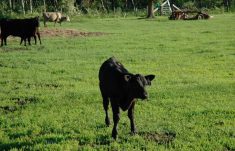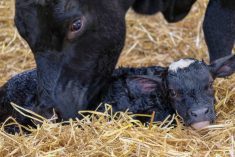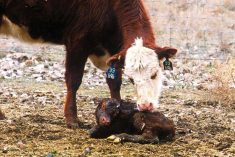In this day and age, when you have the first case of scours develop, most veterinarians would advise to give electrolytes to counter dehydration, other ancillary treatments such as NSAIDs (anti-inflammatory medications) and if necessary, antibiotics.
If a second case arises it’s a good idea to get it diagnosed to know exactly what you’re dealing with. If more cases develop, have an investigation by either your practising veterinarian, or if warranted by a technical services vet with a pharmaceutical company that manufacturers the scour vaccine.
There is no doubt in my mind that administering a scours vaccination to pregnant cows before calving will really help on-farm scours prevention, especially in the larger herds that calve in the winter or early spring with cattle in close proximity.
Read Also

Harvest wraps up and fall work begins
At the Eppich famly ranch in western Saskatchewan, the fall harvest was successful with few breakdowns, cows and calves have been sorted and a new tractor has arrived
There are three scour vaccines on the market in Canada. I believe all are pretty good at getting protection for the different common causes of scours into the colostrum. When the calf is born and begins to nurse, the protection is in that first milk.
Each vaccine has slight differences in its makeup, such as slightly better clostridial protection in one vaccine to a little broader E Coli protection in another. For the most common scour-causing organisms, they are all similar. The other difference worth noting is that one vaccine is given subcutaneously.
Timing is the key
The most important management decision involves choosing the best and easiest time to administer the vaccine. That to me is the most important decision when choosing which vaccine. Each product has its recommended timing, so select the one that fits with your herd management. Proper timing is necessary to get the maximum protection to the specific diseases in the colostrum.
The next item with any scours investigation is looking into whether the best colostrum is being made and if it’s consumed at the proper time. Body condition score and overall nutrition of the mother cow, including a balanced mineral and vitamin program, are necessary for production of good-quality colostrum. It is also important to consider if the cow has the genetic ability to produce enough milk (and colostrum) for the calf.
If the colostrum quality is poor or there isn’t enough, we get failure of passive transfer of important antibodies from the mother.
Other factors include the calf’s ability and vigour to nurse. If teat structure is poor, it can be difficult for the calf to grasp and suck what I call ‘large coke bottle-looking’ teats. Also, if the cow has twins, there could be a fight over the amount of colostrum produced and one calf may get there first and take most of the colostrum.
All the aforementioned reasons are excellent to support the use of powdered colostrum replacements. One product developed at the Western College of Veterinary Medicine in the 1990s and marketed in Western Canada is called Headstart. It is essentially dehydrated colostrum collected from dairy cows across Western Canada.
The product has been around a while and has stood the test of time. Most producers do not hesitate giving a colostrum replacer such as this if there is any doubt whether a calf has sucked or if there is concern about if the cow or heifer has sufficient milk production. The decision to let the calf suck colostrum from the teat or receive it by tube feed must be made in the first few hours of life.
There are two main reasons to be ever-vigilant about colostral uptake. First, there is the health of the calf itself. And second, keep in mind the first calf that gets sick can spread the organisms and may cause overwhelming exposure to other calves.
That is why isolation of calf and mother and maximizing biosecurity by using boot dips to prevent disease spread is important. Changing coveralls and using a different esophageal feeder goes a long way to preventing the second, third, fourth and fifth case.
Prevention is key. Just be aware that disease organisms can be spread from the scours manure in the straw, or carried on your boots or coveralls. They can easily be spread, making newborns especially susceptible.
If only one person is responsible for checking calves, they should look after the newborn calves first and then proceed to look after the sick ones, making sure they clean up very well afterward. We are the custodians of care and can be the greatest spreader of disease when it comes to scours.
Here’s wishing everyone a good calving season, hopefully free of scours. Remember to pay close attention to the timing of vaccination and select the vaccine that fits best into your management time frame.















